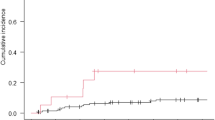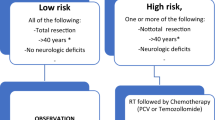Abstract
This review identifies the current literature on the use of bevacizumab for cerebral radiation necrosis in patients with high-grade gliomas, summarizes the clinical course and complications following bevacizumab, and discusses the relative costs and benefits of this therapeutic option. A Medline search was conducted of all clinical studies before September 2012 investigating outcomes following use of bevacizumab therapy for radiation necrosis in patients with high-grade gliomas. Clinical and radiographic outcomes are reviewed. Seven studies reported a total of 30 patients with high-grade gliomas treated with bevacizumab for radiation necrosis. All patients demonstrated decreased radiographic volume of edema on T1 and T2 MRI sequences. Clinical outcomes were reported for 23 patients: 16 (70 %) had improvement in neurologic signs or symptoms, 5 (22 %) had mixed results, and 2 (9 %) remained neurologically unchanged. Complications were documented in 5 of 7 studies (18 of 29 patients, 62 %) and included deep vein thrombosis, pulmonary embolism, visual field worsening, worsening hemiplegia, pneumonia, seizure, and fatigue. Only one study evaluated quality of life measures and none evaluated cost or cost effectiveness. Data regarding the use of bevacizumab to treat radiation necrosis in patients with high-grade gliomas is limited and primarily class III evidence. While bevacizumab improves neurological symptoms and reduces radiographic volume of necrosis-associated cerebral edema, it comes at the expense of a high rate of potentially serious complications. Definitive evidence for the utility, cost-effectiveness, and overall efficacy of this management strategy is currently lacking and additional investigation is warranted.
Similar content being viewed by others
References
Stupp R, Mason WP, Van den Bent MJ et al (2005) Radiotherapy plus concomitant and adjuvant temozolomide for glioblastoma. N Engl J Med 352(10):987–996
Siu A, Wind JJ, Iorgulescu JB et al (2012) Radiation necrosis following treatment of high grade glioma—a review of the literature and current understanding. Acta Neurochir (Wien) 154(2):191–201 discussion 201
Giglio P, Gilbert MR (2003) Cerebral radiation necrosis. Neurologist 9(4):180–188
Chin LS, Ma L, DiBiase S (2001) Radiation necrosis following gamma knife surgery: a case-controlled comparison of treatment parameters and long-term clinical follow up. J Neurosurg 94(6):899–904
Brandsma D, Stalpers L, Taal W, Sminia P, Van den Bent MJ (2008) Clinical features, mechanisms, and management of pseudoprogression in malignant gliomas. Lancet Oncol 9(5):453–461
Chamberlain MC, Glantz MJ, Chalmers L, Van Horn A, Sloan AE (2007) Early necrosis following concurrent Temodar and radiotherapy in patients with glioblastoma. J Neurooncol 82(1):81–83
Fink J, Born D, Chamberlain MC (2011) Pseudoprogression: relevance with respect to treatment of high-grade gliomas. Curr Treat Options Oncol 12(3):240–252
Brandes AA, Tosoni A, Spagnolli F et al (2008) Disease progression or pseudoprogression after concomitant radiochemotherapy treatment: pitfalls in neurooncology. Neuro Oncol 10(3):361–367
Ruben JD, Dally M, Bailey M et al (2006) Cerebral radiation necrosis: incidence, outcomes, and risk factors with emphasis on radiation parameters and chemotherapy. Int J Radiat Oncol Biol Phys 65(2):499–508
Wang Y, Pan L, Sheng X et al (2012) Reversal of cerebral radiation necrosis with bevacizumab treatment in 17 Chinese patients. Eur J Med Res 17(1):25
Drappatz J, Schiff D, Kesari S, Norden AD, Wen PY (2007) Medical management of brain tumor patients. Neurol Clin 25(4):1035–1071, ix
Hart GB, Mainous EG (1976) The treatment of radiation necrosis with hyperbaric oxygen (OHP). Cancer 37(6):2580–2585
Chuba PJ, Aronin P, Bhambhani K et al (1997) Hyperbaric oxygen therapy for radiation-induced brain injury in children. Cancer 80(10):2005–2012
Kohshi K, Imada H, Nomoto S et al (2003) Successful treatment of radiation-induced brain necrosis by hyperbaric oxygen therapy. J Neurol Sci 209(1–2):115–117
Bui Q-C, Lieber M, Withers HR et al (2004) The efficacy of hyperbaric oxygen therapy in the treatment of radiation-induced late side effects. Int J Radiat Oncol Biol Phys 60(3):871–878
Glantz MJ, Burger PC, Friedman AH et al (1994) Treatment of radiation-induced nervous system injury with heparin and warfarin. Neurology 44(11):2020–2027
Gonzalez J, Kumar AJ, Conrad CA, Levin VA (2007) Effect of bevacizumab on radiation necrosis of the brain. Int J Radiat Oncol Biol Phys 67(2):323–326
Levin VA, Bidaut L, Hou P et al (2011) Randomized double-blind placebo-controlled trial of bevacizumab therapy for radiation necrosis of the central nervous system. Int J Radiat Oncol Biol Phys 79(5):1487–1495
Matuschek C, Bölke E, Nawatny J et al (2011) Bevacizumab as a treatment option for radiation-induced cerebral necrosis. Strahlenther Onkol 187(2):135–139
Arratibel-Echarren I, Albright K, Dalmau J, Rosenfeld MR (2011) Use of bevacizumab for neurological complications during initial treatment of malignant gliomas. Neurologia 26(2):74–80
Torcuator R, Zuniga R, Mohan YS et al (2009) Initial experience with bevacizumab treatment for biopsy confirmed cerebral radiation necrosis. J Neurooncol 94(1):63–68
Furuse M, Kawabata S, Kuroiwa T, Miyatake S-I (2011) Repeated treatments with bevacizumab for recurrent radiation necrosis in patients with malignant brain tumors: a report of 2 cases. J Neurooncol 102(3):471–475
Gronier S, Bourg V, Frenay M et al (2011) Bevacizumab for the treatment of cerebral radionecrosis. Rev Neurol (Paris) 167(4):331–336
Thompson EM, Frenkel EP, Neuwelt EA (2011) The paradoxical effect of bevacizumab in the therapy of malignant gliomas. Neurology 76(1):87–93
Kelly PJ, Dinkin MJ, Drappatz J, O’Regan KN, Weiss SE (2011) Unexpected late radiation neurotoxicity following bevacizumab use: a case series. J Neurooncol 102(3):485–490
Sherman JH, Aregawi DG, Lai A et al (2009) Optic neuropathy in patients with glioblastoma receiving bevacizumab. Neurology 73(22):1924–1926
Galanis E, Anderson SK, Lafky JM, Uhm J, Giannini C, Kumar SK et al (2013) Phase II study of bevacizumab in combination with sorafenib in recurrent glioblastoma (N0776): A North Central Cancer Treatment Group Trial. Clin Cancer Res. doi:10.1158/1078-0432.CCR-13-0708
Fleming T (ed) (2007) Red book: pharmacy’s fundamental reference, 111th ed. Thomson, Belmont
Shiroiwa T, Sung Y-K, Fukuda T et al (2010) International survey on willingness-to-pay (WTP) for one additional QALY gained: what is the threshold of cost effectiveness? Health Econ 19(4):422–437
Dropcho EJ (2012) Should the cost of care for patients with glioblastoma influence treatment decisions? Continuum (Minneap Minn) 18(2):416–420
Acknowledgments
None.
Conflict of interest
The authors have no conflicts of interest to declare.
Author information
Authors and Affiliations
Corresponding author
Rights and permissions
About this article
Cite this article
Lubelski, D., Abdullah, K.G., Weil, R.J. et al. Bevacizumab for radiation necrosis following treatment of high grade glioma: a systematic review of the literature. J Neurooncol 115, 317–322 (2013). https://doi.org/10.1007/s11060-013-1233-0
Received:
Accepted:
Published:
Issue Date:
DOI: https://doi.org/10.1007/s11060-013-1233-0




